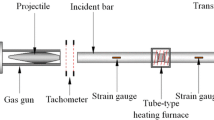Summary
The Kaiser effect is a measure of damage developed in rock. It was investigated using 61 core specimens of eight types of rocks under uniaxial cyclic loading. The effects of the delay time between subsequent loading cycles and the holding time on the Kaiser effect were examined in granite specimens. The characteristics of AE occurring during unloading and holding were also studied. The experimental results showed that most of the rocks, with the exception of some iron ores, showed an obvious Kaiser effect before the load was very near the level of the strength. The delay and holding times did not strongly influence the Kaiser effect. Breakdown of the Kaiser effect was expressed by the felicity ratio that may be taken as a measure of the quality of rock. The onset of the continuously increasing AE in the first loading cycle can be taken as a measure of the damage in rock. The mechanism of the Kaiser effect was studied with the aid of a micromechanical model. An expression for the damage surface in the stress space was derived from the model. The theoretical expression was compared with the results of the Kaiser effect tests, which showed a satisfactory consistence.
Similar content being viewed by others
References
Hayashi, M., Kanagawa, T., Hibino, S., Motozima, M., Kitahara, Y. (1979): Detection of anisotropic geo-stresses trying by acoustic emission, and nonlinear rock mechanics on large excavating caverns. In: Proc., 4th Int. Congress on Rock Mechanics, Montreux, vol. 2, 211–218.
Holcomb, D. J. (1983): Using acoustic emissions to determine in-situ stress: problem and promise. In: Proc., Applied Mechanics, Bioeng. and Fluids Eng. Conference, Houston, 11–21.
Holcomb, D. J. (1985): Summary of discussions on behaviour of solids with a system of cracks. In: Bazant, Z. P. (ed.) Mechanics of geomaterials: rocks, concretes, soils. J. Wiley, New York, 571–573.
Holcomb, D. J., Costin, L. S. (1986): Detection damage surfaces in brittle materials using acoustic emissions. Trans. ASME 53, 536–544.
Holcomb, D. J., Stone, C. M., Costin, L. S. (1990): Combining acoustic emission locations and a microcrack damage model to study development of damage in brittle materials. In: Hustrulid, W. A., Johnson, G. A. (eds.) Proc., 31st U. S. Symposium, Rock Mechanics Contributions and Challenges. Balkema, Rotterdam, 645–651.
Hughson, D. R., Crawford, A. M. (1986): Kaiser effect gauging: A new method for determining the pre-existing in-situ stress from an extracted core by acoustic emissions. In: Proc., Int. Symposiums on Rock Stress Measurements, Stockholm, 359–368.
Hughson, D. R., Crawford, A. M. (1987): Kaiser effect gauging: The influence of confining stress on its response. In: Proc., 6th Int. Congress on Rock Mechanics, Montreal, vol. 2, 981–985.
Kaiser, E. J. (1959): A study of acoustic phenomena in tensile test. Doctoral Thesis, Technische Hochschule München.
Kanakawa, T., Hayashi, M., Kitahara, Y. (1981): Acoustic emission and overcoring methods for measuring tectonic stress. In: Proc., Int. Symposium on Weak Rock Tokyo, 1205–1210.
Kranz, R. L. (1979): Crack-crack and crack pore interaction in stressed granite. Int. J. Rock Mech. Min. Sci. Geomech. Abstr. 19, 49–64.
Kurita, K., Fuji, N. (1979): Stress memory of crystalline rocks in acoustic emission. Geophys. Res. Lett. 6 (1), 9–12.
Li, C., Nordlund, E. (1993a): Effects of couplants on the acoustic transmission. Rock Mech. Rock Engng. 26 (1), 63–69.
Li, C., Nordlund, E. (1993b): Deformation of brittle rocks under compression with particular reference to microcracks. Mech. Mater. 15, 223–239.
Michihiro, K., Fujiwara, T., Yoshioka, H. (1985): Study on estimating geostresses by the Kaiser effect of AE. In: Proc., 26th U.S. Symposium on Rock Mechanics, Rapid City, 557–564.
Nordlund, E., Li, C. (1990): Acoustic emission and the Kaiser effect in rock materials. In: Hustrulid, W. A., Johnson, G. A. (eds.) Rock mechanics contributions and challenges. Proc., 31st U.S. Symposium. Balkema, Rotterdam, 1043–1050.
Tanimoto, K., Nakamuna, J., Fudo, R. (1978): Application of acoustic emission in in-situ test. In: Proc., 10th Int. Conference on Soil Mechanics and Foundation Engineering, vol. 2, Balkema, Rotterdam, 573–576.
Tapponnier, P., Brace, W. F. (1976): Development of stress-induced microcracks in Westerly granite. Int. J. Rock Mech. Min. Sci. Geomech. Abstr. 13, 103–112.
Wong, T.-F. (1982): Micromechanics of faulting in Westerly granite. Int. J. Rock Mech. Min. Sci. Geomech. Abstr. 19, 49–64.
Author information
Authors and Affiliations
Rights and permissions
About this article
Cite this article
Li, C., Nordlund, E. Experimental verification of the Kaiser effect in rocks. Rock Mech Rock Engng 26, 333–351 (1993). https://doi.org/10.1007/BF01027116
Issue Date:
DOI: https://doi.org/10.1007/BF01027116



